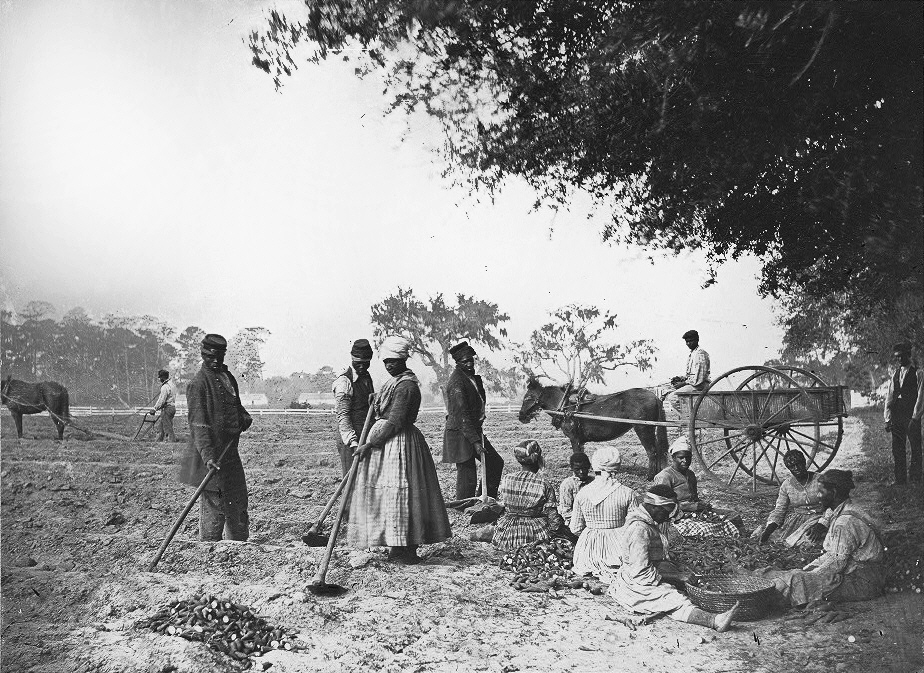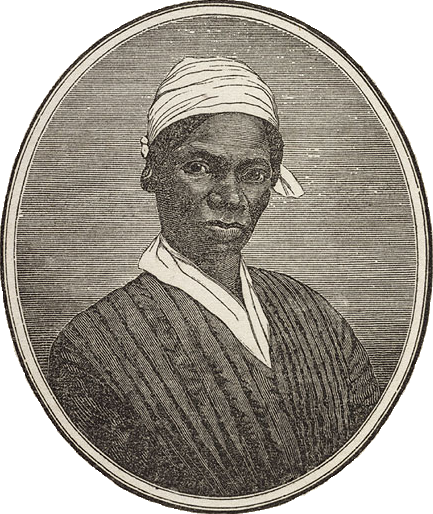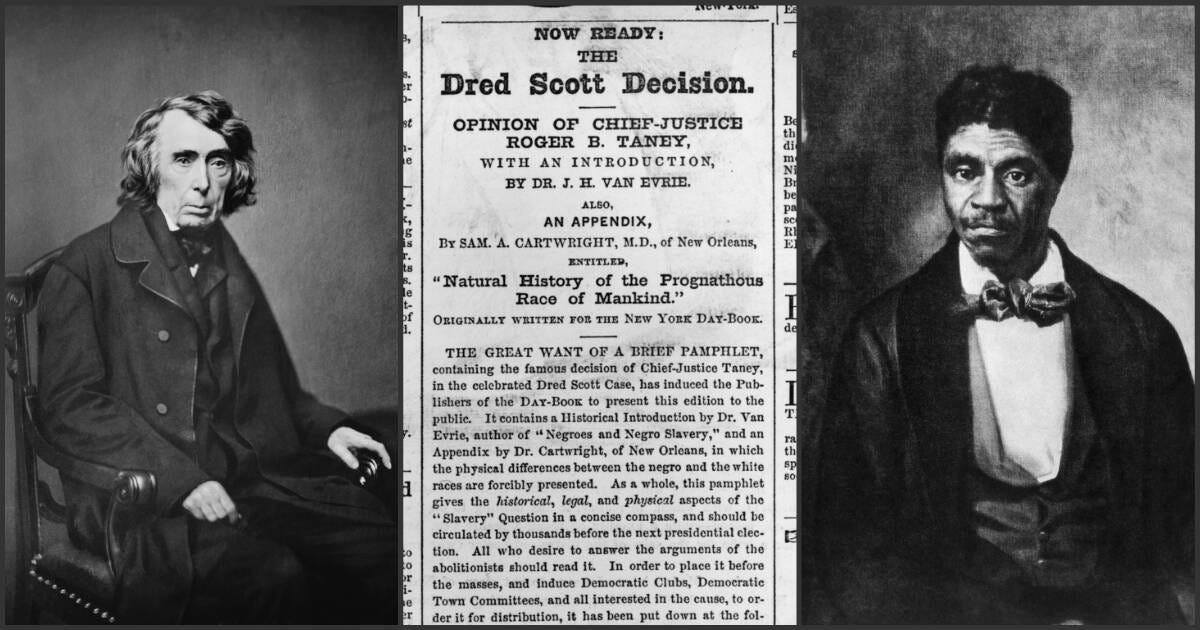African American men and women work on a southern plantation, 1862

Topics on this page:
Background on Slavery
- Facts about Slavery in the South
Cross-Link: The Origins of the Atlantic Slave Trade
Slavery and Racism
 Dramatic Event page: The Amistad Case
Dramatic Event page: The Amistad Case
Life as a Slave
- Gordon, A Slave
- Solomon Northrup
- Harriet Jacobs
- Sojourner Truth
 Influential Literature page: Uncle Tom's Cabin
Influential Literature page: Uncle Tom's Cabin
Expansion of Slavery
Dramatic Event page: Eli Whitney and the Development of the Cotton Gin
The Slave Trade
- Slavery in the Caribbean and South America
Developing Legal Precedents
- Prigg v. Pennsylvania (1842)
- Dred Scott v. Sanford (1857)
The Civil War
Cross-Link: Debates Over Slavery and the Coming of the Civil War
|
PAGE SUMMARY
-
Baseline facts and understandings about slavery in the American South
-
The U.S. slave population multiplied 10x between 1780 and 1860.
-
The cotton gin was invented; which accelerated the amount of work expected by slaves.
-
¼ of all southern white families owned slaves.
-
There exists an inherent link between American chattel slavery and racism.
-
There were divisive debates on slavery even within the South.
-
Life as a slave differed depending on one’s location, master, gender, and age—but all experienced the brutal oppression inherent to race-based human trafficking.
-
The Civil War hinged around the question of slavery—or rather, a “state’s right” to continue enslaving Black individuals for commercial profit. But emancipation was never guaranteed, nor did it come altruistically from Lincoln. (William Huntington, March 2022)
|
 Cross-Link to AP U.S. History Key Concept 4.2: Economic Transformations in Antebellum America
Cross-Link to AP U.S. History Key Concept 4.2: Economic Transformations in Antebellum America
 Teaching Hard History: American Slavery, Teaching Tolerance/Southern Poverty Law Center (2018)
Teaching Hard History: American Slavery, Teaching Tolerance/Southern Poverty Law Center (2018)
A Framework for Teaching American Slavery
Focus Questions
-
What accounted for the rapid growth of slavery in the South after 1800?
-
What was the impact of the cotton gin on slavery and Southern agriculture?
 For an historical perspective on slavery in the Americas, see Ira Berlin's books: Many Thousands Gone (2000), Generations of Captivity (2004), and The Making of African America (2010).
For an historical perspective on slavery in the Americas, see Ira Berlin's books: Many Thousands Gone (2000), Generations of Captivity (2004), and The Making of African America (2010).
Read Howard Zinn's account of slavery in America, from A People's History of the United States.
 |
Number of slaves by state, 1770 to 1860
|
Slaves going to the field

Facts about slavery in the South
- The South's slave population increased ten-fold between 1780 and 1860.
- Southern slavery was especially brutal and degrading and the sale of slaves from the old South to the new territories broke apart many African families.
- The cotton gin expanded the system of slavery by making it possible to harvest "short staple" cotton throughout the South.
- Three-quarters of all southern White families owned no slaves. However, this should not take away from the brutal history of slavery and racism.
- Those who didn't own slaves aspired to own slaves and participated in setting up a racist society that has oppressed Black Americans through this day (although in different ways and on a different scale).
- A typical slave owner worked a family farm with about 10 slaves
- About 10,000 families owned 50 more slaves on large plantations
- The South also had a small free Black population that occupied an uneasy place in the class system
- Slaves resisted bondage by many different means from slave revolts to establishing their own cultural traditions (Information taken from Lessons from History: Essential Understandings and Historical Perspectives Students Should Acquire, National Center for History in the Schools, 1992).
 Learning plan about slavery and using primary sources http://www.loc.gov/teachers/classroommaterials/lessons/slavery/
Learning plan about slavery and using primary sources http://www.loc.gov/teachers/classroommaterials/lessons/slavery/
Interactive maps about the spread of slavery in the US https://www.smithsonianmag.com/history/maps-reveal-slavery-expanded-across-united-states-180951452/
Slavery and Racism
The institution of slavery is intrinsically related to the development of racist ideologies and the construction of racial identities which still play a prominent role in American society.
Read a background of "The Historical Origins and Development of Racism" in the Western world, from PBS.
Read about how "Legacy of Slavery Still Fuels Anti-Black Attitudes in the Deep South," in this study from the University of Rochester.
View some early images of slaves, taken by J.T. Zealy in the 1850s in South Carolina. WARNING: some may find the images disturbing, or inappropriate for classroom viewing.
These Daguerreotypes were commissioned by Louis Agassiz, a biologist from Harvard University who wanted to use the images as evidence to support his ideas of scientific racism.
 View a Crash Course video providing an informative overview on this topic, including what life was like for a slave in the 19th century United States and how slaves resisted oppression.
View a Crash Course video providing an informative overview on this topic, including what life was like for a slave in the 19th century United States and how slaves resisted oppression.
View this resource from Rutgers University to find films about race and slavery.
The racist legacy of slavery is not contained to the American South.
https://www.smithsonianmag.com/history/maps-reveal-slavery-expanded-across-united-states-180951452/
Divisions Between the Upper and Lower South on the Question of Slavery
- In the Upper South, politicians and planters favored a slow extinction of slavery.
- However, this was due to the fact that the Upper South's economy wasn't solely based on cotton production. Cotton production and the resulting economy in the Deep South rested on slavery.
- In order to gain more power within federal government, the lower South started to push for the end of slavery. These southerners publicly regarded the institution as "dangerous, morally indefensible, unrepublican and economically retrograde." However, a solid argument can be made that if the Lower South was dependent on slave labor for the success of their economy, they would've had no problem with slavery.
This article shows the arguments for and against slavery from both Northern and Southern states prior to the Civil War: https://www.battlefields.org/learn/articles/slavery-united-states
Removing slavery was never about racial equality.
Life as a Slave
- In the lower South the majority of slaves lived and worked on cotton plantations. Most of these plantations had fifty or fewer slaves, although the largest plantations have several hundred. Cotton was by far the leading cash crop, but slaves also raised rice, corn, sugarcane, and tobacco.
- Besides planting and harvesting, there were numerous other types of labor required on plantations and farms. Enslaved people had to clear new land, dig ditches, cut and haul wood, slaughter livestock, and make repairs to buildings and tools. In many instances, they worked as mechanics, blacksmiths, drivers, carpenters, and in other skilled trades.
- Black women carried the additional burden of caring for their families by cooking and taking care of the children, as well as spinning, weaving, and sewing.
- The diets of enslaved people were inadequate or barely adequate to meet the demands of their heavy workload. They lived in crude quarters that left them vulnerable to bad weather and disease. Their clothing and bedding were minimal as well. Slaves who worked as domestics sometimes fared better, getting the castoff clothing of their masters or having easier access to food stores.
- The heat and humidity of the South created health problems for everyone living there. However, the health of plantation slaves was far worse than that of whites. Unsanitary conditions, inadequate nutrition and unrelenting hard labor made slaves highly susceptible to disease. Illnesses were generally not treated adequately, and slaves were often forced to work even when sick.
- One of the worst conditions that enslaved people had to live under was the constant threat of sale. Slaves were sometimes sold as a form of punishment. Immediate families were often separated.
- African American women had to endure the threat and the practice of sexual exploitation. There were no safeguards to protect them from being sexually stalked, harassed, or raped, or to be used as long-term concubines by masters and overseers.
- The drivers, overseers, and masters were responsible for plantation discipline. Slaves were punished for not working fast enough, for being late getting to the fields, for defying authority, for running away, and for a number of other reasons. The punishments took many forms, including whippings, torture, mutilation, imprisonment, and being sold away from the plantation. Slaves were even sometimes murdered.
- In addition to the authority practiced on individual plantations, slaves throughout the South had to live under a set of laws called the Slave Codes. The codes varied slightly from state to state, but the basic idea was the same: the slaves were considered property, not people, and were treated as such. Slaves could not testify in court against a white, make contracts, leave the plantation without permission, strike a white (even in self-defense), buy and sell goods, own firearms, gather without a white present, possess any anti-slavery literature, or visit the homes of whites or free blacks. The killing of a slave was almost never regarded as murder, and the rape of slave women was treated as a form of trespassing.
- Whenever there was a slave insurrection, or even the rumor of one, the laws became even tighter. At all times, patrols were set up to enforce the codes. During times of insurrection -- either real or rumored -- enraged whites formed vigilance committees that terrorized, tortured, and killed blacks.
- While most slaves were concentrated on the plantations, there were many slaves living in urban areas or working in rural industry. Although over 90% of American slaves lived in rural areas, slaves made up at least 20% of the populations of most Southern cities. In Charleston, South Carolina, slaves and free blacks outnumbered whites. Many slaves living in cities worked as domestics, but others worked as blacksmiths, carpenters, shoemakers, bakers, or other tradespeople.
Gordon, A Slave
- In March 1863, a man known only as Gordon escaped from slavery on a Louisiana plantation and after a harrowing journey found safety among Union soldiers encamped at Baton Rouge.
- Before enlisting in a black regiment, he was examined by military doctors, who discovered horrific scarring on his back—the result of a vicious whipping by his former overseer.
- This photograph documenting Gordon’s condition was later published in Harper's Weekly and created a sensation when it reached the public. It quickly became one of the most powerful proofs of slavery’s brutality.
- Sergeant Gordon was later reported to have fought bravely in the Union assault on Port Hudson, but nothing further is known about his life.
Solomon Northrup


American Slave Narratives: An Online Anthology, University of Virginia
Read "Twelve Years a Slave," a first-hand account of slave life by Solomon Northup.
- For material on the Middle Passage and Slave Life, go the following link from the Africans in America series from PBS.
- A Port of Entry for Enslaved Africans from Charlestown's African-American Heritage.
- It is estimated that 40 to 60 percent of Africans who were brought to America entered through the South Carolina LowCountry.
Harriet Jacobs
 |
| Harriet Jacobs, 1894 |
Incidents in the Life of a Slave Girl (1861), written by Harriet Jacobs under the pen name Linda Brent describes the life of a female house slave in the South before the Civil War.
The Interesting Narrative of the Life of Olaudah Equiano written by himself describes the journey of slave from capture to freedom.
Video about Harriet Jacobs https://www.youtube.com/watch?v=5q8R2Vs5qGo (Warning: this video discusses rape and sexual assault)

Sojourner Truth 1797-1883
- Sojourner Truth was born enslaved in New York State
- After gaining her freedom she wrote an autobiography and many speeches in support of Abolition and Women's Rights
-
The Dinner Party by Judy Chicago is an icon of feminist art, which represents 1,038 women in history—39 women are represented by place settings and another 999 names are inscribed in the Heritage Floor on which the table rests.
-
This monumental work of art is comprised of a triangular table divided by three wings, each 48 feet long.
Dramatic Event page: Eli Whitney and the Cotton Gin
- In 1794, U.S.-born inventor Eli Whitney (1765-1825) patented the cotton gin, a machine that revolutionized the production of cotton by greatly speeding up the process of removing seeds from cotton fiber.
- By the mid-19th century, cotton had become America’s leading export.
- Despite its success, the gin made little money for Whitney due to patent-infringement issues.
- His invention offered Southern planters a justification to maintain and expand slavery even as a growing number of Americans supported its abolition, leading to the rapid growth of slavery in the deep south.
Impacts of the Cotton Gin
- Slavery was concentrated in the upper south for the production of tobacco and rice prior to the invention of the cotton gin. But by the time the cotton gin was invented the soil of the upper south in the areas of the Virginia were being exhausted of its nutrients.
- The cotton gin allow for the separation of the seed from short staple cotton making in profitable for the harvesting of cotton.
- Therefore slavery and cotton production moved into the deep south which included the states of South Carolina, Georgia, Florida, Mississippi, Louisiana, Alabama and Texas which had a climate that was conducive for cotton to flourish.
- Between 1820 and 1860 cotton production in America rapidly increased.
- By 1860 cotton accounted for 58% of American exports and 75% of the world's entire supply of cotton.
- The cotton produced by the south fueled the textile industries of the North and Great Britain which helped usher in the industrial revolution.

View a HIstory channel video on Eli Whitney and the cotton gin.
Ted-Ed video on the cotton gin https://www.youtube.com/watch?v=0SMNYivhGsc
Interactive website which includes description, video, images, and articles about the cotton gin https://kids.britannica.com/students/article/cotton-gin/625479
The Slave Trade
This page will allow the user to view over 30,000 documented voyages during the Slave Trade, between 1514-1866. You can select destinations, countries involved, times, number of enslaved peoples shipped, etc. This page shows just how large the trade itself was. https://www.slavevoyages.org/voyage/database
This article includes a map with totals of how many slaves were delivered to different parts of the World: https://www.statista.com/chart/19068/trans-atlantic-slave-trade-by-country-region/
The Diligent: A Voyage Through the Worlds Of The Slave Trade by Robert Harms provides an account of the Slave Trade with a focus on one French Ship, thanks to a discovered journal of the captain: https://www.amazon.com/Diligent-Voyage-Through-Worlds-Slave/dp/0465028721
The Slave Ship: A Human History by Marcus Rediker provides a history of Slave Voyages, sometimes form the perspective of a crew member on the ships or a newly enslaved person: https://www.amazon.com/Slave-Ship-Human-History/dp/0143114255
Slavery in South America
http://slaveryandremembrance.org/articles/article/?id=A0011
https://notevenpast.org/race-and-slavery-in-colonial-latin-america/
https://www.dw.com/en/in-brazil-the-wounds-of-slavery-will-not-heal/a-43754519
Slavery in the Caribbean
http://www.nationalarchives.gov.uk/caribbeanhistory/slavery-negotiating-freedom.htm
https://www.liverpoolmuseums.org.uk/archaeologyofslavery/slavery-caribbean
Developing Legal Precedents
Prigg v. Pennsylvania (1842):
-
Therefore, the Fugitive Slave Act of 1793 thereafter trumped state legislation, regardless of state status. This meant that slave hunters could travel into states and extract any escaped slaves who managed to make it to a free state without legal retaliation.
Dred Scott v. Sanford (1857):
-
Dred Scott sued his enslaver, John F.A. Sanford, for his freedom, invoking Article III of the U.S. Constitution. Scott had been stolen from the "free state" of Illinois and was enslaved in Missouri.
-
The U.S. Supreme Court ruled that Black individuals could not be free, or otherwise claim citizenship, through Article III of the Constitution. Furthermore, Supreme Court Justice Taney reaffirmed that slaves were property under the Fifth Amendment, and that any law that would deprive a slave owner of that property was unconstitutional.

Photo depicting Supreme Court Justice Taney (left), a newspaper clipping that was published the day after the
Dredd Scott decision was delivered (middle), and Dred Scott himself (right),
The Civil War
-
The secession of the southern states came after Lincoln announced a policy that would make all new states that enter the Union free states. The secession caused the Civil War, but Deep Southerners, as well as Northerners, attempted to keep the war about making the Union whole again.
The Civil War didn't become about slavery until Lincoln was forced to deal with the number of escaped slaves crossing Union lines.
- Again, Lincoln was never for racial equality.
- Lincoln only signed the Emancipation Proclamation when he realized that the war had become about slavery. Furthermore, the Emancipation Proclamation, put into effect in January of 1863, did not really free slaves immediately because Southern cities and towns were not just going to follow a federal mandate. Slaves were only freed from slavery when Union soldiers occupied towns in the South. However, this proclamation did have major impacts because it turned the Civil War into a war over slavery. The end of the war then became tied to the end of slavery. Southern states then became to set up the Black Codes and Jim Crow Laws post-slavery and post-Reconstruction.
- Here is a link to the Emancipation Proclamation.
- The number of escaped slaves forced Lincoln and all white Americans to turn the Civil War into a war over slavery
- The First Confiscation Act of August 1861 “provided for the seizure of all property used in rebellion, including slaves”. This allowed the Union soldiers to capture slaves as contraband and use them in the war effort, as long as they had fought for the South.
- However, the number of slaves crossing Union lines was still increasing and it forced Congress to put into effect the Second Confiscation Act in July 1862. This act stated, “any enslaved person that crosses Union lines can be “captured” regardless of if they were used in the war effort”.
- Many Northerners still didn’t want to see African Americans armed, including President Lincoln, but once regiments were put in place to allow African Americans to fight, they proved their worth.
- Without slaves pushing for their own freedom, they never would've earned it. Lincoln freed the slaves, but if it weren't for Black Americans pushing for their own freedom, freedom would've never come. All throughout history, white men with power and privilege ignored the civil rights and oppression of other races until forced to deal with them.
Comments (0)
You don't have permission to comment on this page.